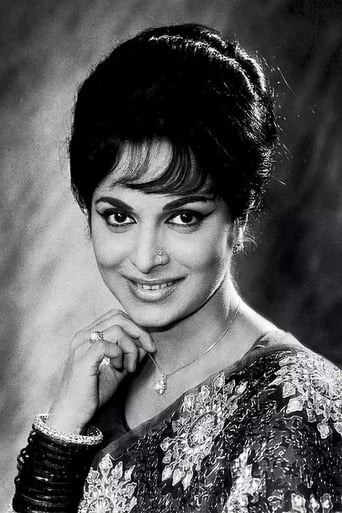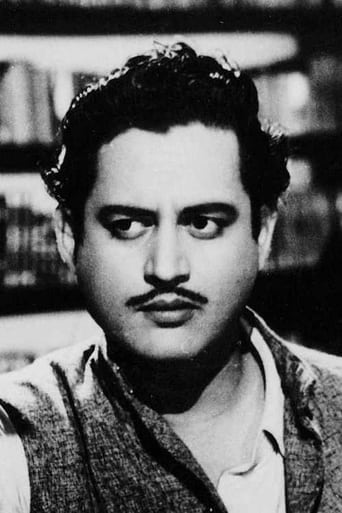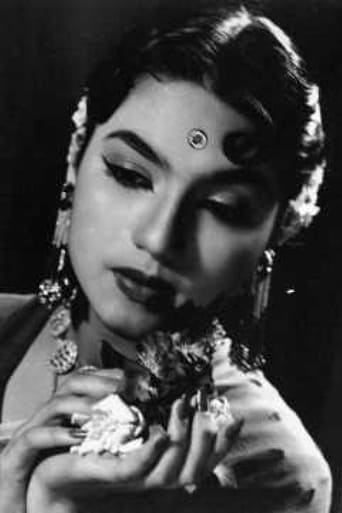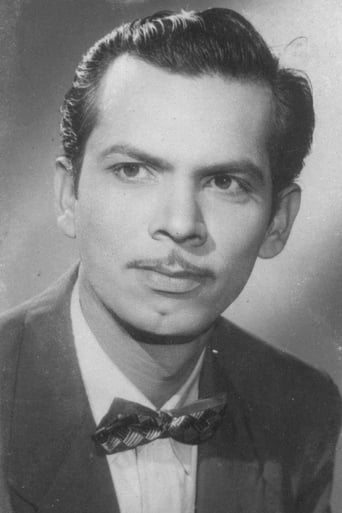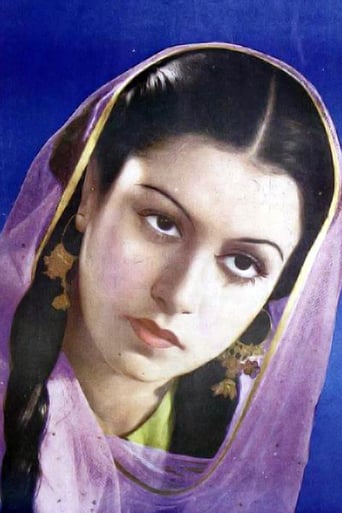nadjacs
Reading some of the reviews makes me think that this film needs more context for an American audience and may not be fully appreciated if it is the first classic Bollywood movie one watches, but if you are interested in classic cinema (not just classic Bollywood) it really must be seen.Yes, Sinha's wife and her family are caricatures, yes Rocky's character is ridiculous, yes the beginning and end are melodramatic (no more so than many other classics, though), but everything else is artistry. Sinha and Shanti both have excellent, minimalist dialogue and express themselves well through body language and facial expression without becoming caricatures themselves. Maybe I'm reading too much into it but I think perhaps the contrast between the flat portrayal of the anti-film characters and the realistic portrayal of the main characters is more than just an attempt to please the audience and is rather an attempt to focus on the true drama. As if to say, yes, the protagonists are suffering because of these problems, but it is their suffering that we want you to look at, not the situation that caused it.The technical quality of the prints available (both picture and audio) are somewhat poor at times but for me this did not detract from my experience. I can see why it was a failure in the box office at the time. It wasn't the type of story the mass market generally wants, and especially not at the time it was made, but it is also clear why it is now considered a masterwork.
folkpoet80
This movie sums up the genius of Guru Dutt. A reclusive and introvert man portrayed in the movie was Dutt himself. Too bad the movie went over the heads of Audience in the 50s, however, its charisma has given it the status of a cult classic. Waheeda Rahman was beautiful as ever and acted much better than she did in Pyaasa. I rate this movie better than Pyaasa personally. Kaifi Azmi's lyrics are at their best with "Waqt ne kiya" song topping everything out! I think the beginning is extremely maudlin and same for the ending. He enters the studio as an old and broken man, only to be jeered at by his ex colleagues. A must watch with outstanding Music!!!!
ThurstonHunger
I'm still slowly developing my appreciation for "Bollywood" although this film certainly does not fit the prototype for what I've seen and expected thusfar. Instead of sassiness and splash, this epic traverses seriousness and shadow.I'm certainly glad that I saw it, but truth be told I'm happier having seen it, than I was while actually watching it. By renting the DVD, I was able to watch a 3-part special on Guru Dutt that I highly recommend. His colleagues still speak so fondly and insightfully of him, very touching. It might be worth watching that special before the main feature. The film is from 1959 and thus has elements that are timeless, yet also elements that are quite dated.First off, it is in black and white, and several scenes (not only those involving knitting) screamed for color, but alas what can you do? Is there a Ted Turner in India?? Kidding!! The camera work and shots however are often remarkable, shadows just don't look as stark in color. On the extras, V.K. Murthy discussed the light beams and lenses he created for Dutt. Speaking of Murthy, he was so very compelling on the DVD extras...why does IMDB list him working so rarely? I suspect it is just an incomplete filmography??Dutt and he also used overlapping images that I still enjoy, but I don't think anyone uses these now since they were probably overused at one point in the 60's. Bring 'em back, the sliding limelights and later sliding martinis worked very well. There's a great scene of a throng of adoring film fans where the camera takes on a boat-like rocking that caught my eye. The camera often moves, and shots usually are not interrupted with so many alternative angles as we are used to today. Personally that's one of my favorite aspects of older films, the lingering shot.There was a pivotal scene where I guess they needed two different takes, spliced from nearly the same location after the "sofa" reunion of our two starcrossed lovers. It may be footage was just lost there (other moments during songs for example it was clear this has happened). The sudden change in that scene almost right at that abrupt camera perspective change in the takes used, didn't translate to me in the US in 2004. But I'm usually one to encourage lovers to "requit," damn it!Another significant problem comes with what we an audience, and Dutt/Sinha as a character, allow his daughter to get away with. Again, I'm nothing more than an acolyte in appreciating these Indi films, but it seems a common theme is the man is with one woman, but in love with another. How to construct this barrier in a sassy film that will hypnotize with eye-popping dance scenes over ear-popular music is very different than how to construct a barrier in a serious film such as this.I don't really care in the first case, but here the impudence of the daughter just put me off, and made the unrequited love seem sort of senseless. One of Guru Dutt's contemporaries talked about how in real life, he could love...but not state his love. This is a more interesting divide, and it is presented somewhat here, generally with the enchanting Chanti saying "Listen..." (well that's what the subtitles said...) Three times at least... Winds also pick up at key moments.The film is well constructed with devices like that, and the aforementioned beams of light. The ingenue and the auteur love story works well, a Pygmalion with another pigment. Naivete and innocence are not only what draw Sinha to Chanti, but they are also what some people will like about this film quite a bit.For me, I might be a bit too jaded. The "Rocky" comedic relief (is his name really Johnny Walker...that's like a character out of "Alien Nation") while sorta funny in ways, at the same time got on my nerves a bit. Although for a moment I thought he was going to be well ahead of time and be a gay character on screen in the 50's. Indeed any scene involving any one from his family tended to bring the film down in a broad fashion. We get it, the aristocracy are horrible to the poor and lowly millionaire film mavericks, not willing to give them the compassion they shower upon their dogs. Another clue to dislike them, the fact that they use the English language.I still don't know why at one point the estranged Mrs. Sinha says "If he needs me, put him on the next flight." If she were too sickly to go to her husband in his need, or if a monsoon made it prohibitive to go to Bombay...that might have been better from my point of view.The fact that this is a film about the film industry may put some folks off, but like Altman's "The Player" this film I think benefits from such self-reflection. The notion of a director's struggle for art and control, when the bets are switching to the actors and actresses as workhorses evidently paralleled Dutt's own struggles. Ultimately I think Dutt's own life is more interesting than the role he created and portrayed here. It seems in the artificial cinema sunlight, he felt rootless and never blossomed amidst all the paper flowers.Back at school, I saw some of Sergei Eisenstein's films as part of being a Rhetoric major, I wish we had seen and discussed this film. I'd be curious to know if others found some of the women when speaking looking awkwardly askance? In today's era of reality TV and hand-held documentary style film fiction, I sort of miss stylized movies as an art ...although I'm certainly glad car footage can be shot on real roads and not sound stages these days. ;>Overall I think "Kaagaz Ke Phool" has as much going for it as other film school classics (and being appreciated with a sense of history would help). Although even as a "stand-alone" film I found it entertaining. Not sure I would have said the same of "Battleship Potemkin" sitting at home on a Thursday night.7/10

